Michelle Barker's Blog: Hearing Voices
May 7, 2025
BMO Marathon Race Report
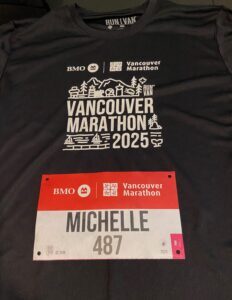
The last six months have been all about running, and I haven’t written anything about it because I was starting to feel superstitious. Getting to the BMO start line was uncertain thanks to injury, and I didn’t want to write about something that I wasn’t completely sure I could do. And then, when I finally made my ‘come hell or high water’ decision, I didn’t want to jinx it.
So, let’s back up to December and the Gunner Shaw 5K, which was the first in a series of races I did before the BMO. This one had been on my radar for years. It’s a cross-country race around Jericho beach and trails… in December. Meaning rain, puddles, and slippery mud are guaranteed. Near the end, there’s an epic—well, you can’t call it a puddle. It’s a pond, about 25 meters long and knee-deep (for me), and yeah, you have to run through it.
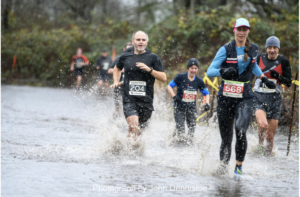
Photo by John Denniston
The Gunner Shaw is as much an obstacle course as it is a race, and it was exactly as fun as I’d anticipated. I hope to do this one every year.
Buoyed by my success in that race, I moved on to the Steveston Icebreaker, an 8K race in early January. I was determined to break 40 minutes, and I did, but it came at a cost. I strained my left hamstring, which left me training through pain to make it to the start line of the First Half, a half-marathon in early February.
Thanks to snowy and icy conditions, the race almost didn’t go ahead (which, let’s be honest, I was hoping for). But they altered the course to keep it safe, and off I went, gritting my teeth through pretty much all 21K. It was nasty, but I survived, and my hamstring wasn’t worse.
Slowly, through strength work and physio exercises, the hamstring injury improved—though it never went away, and it caused other compensatory issues. As I stared down a 25K training run, I knew I had reached a decision point. If I could make it through that, the marathon would be a go. If I couldn’t, I’d have to consider scaling back to a half, which I really didn’t want to do. I had first signed up for the BMO in 2020 when, thanks to Covid, it got canceled. The Victoria Marathon was on my schedule for 2023 but a concussion kept me from doing that one. I did NOT want to back out of this.
The 25K run went well enough for me to commit to the marathon. But my training overall was not what I’d hoped for. I couldn’t do any speed work and for a while no hills either (ha, great for the BMO which has SO MANY HILLS). But the one thing I could do was long slow distance. My longest training run was 37K, which was a game-changer—something I know from my IM marathons where I’d never put in that distance and had paid for it at the end. I trained through both pain and Biblical downpours, which in the end was good. I knew I could endure pretty much anything the race might throw at me.
Race day exceeded all expectations. Vancouver puts on a stellar event, and the weather couldn’t have been better. I was nervous leading up to the day but managed to sleep well the night before and woke up ready, excited, and pretty emotional that I was actually doing it. So much had gone into getting there. Whatever happened during the race, the fact that I was starting was already a win for me.

I had a plan—well, two plans. One was realistic, the other optimistic, and both depended on how I was feeling as the race proceeded. But the first part of my plan was to head out slowly. A lot of people burst out of the gate and pay for it later (we’ll come to that). I’d run the course a number of times in training and knew that it began with a hill which I’d always run slowly. But somehow (the taper? the carb-loading? race day adrenaline?) I had trouble slowing myself down. I had to intentionally rein it in, which I did.
I’d also done the Camosun/Imperial/16th Ave hills a number of times and was dreading them, but again, somehow they were a breeze.
This is a technical course. The first 25k or so is full of hills, both up and down, and then it (sort of) flattens out. I’d been warned particularly about the downhills. You can’t bank time in a marathon. If you fly down those long stretches of downhill, by the time you hit the seawall your quads will quit on you. So I purposely took the hills easy.
In my long training runs, the worst part had always been the stretch from about 23-30K. It’s a grind. Physically you’re tired, and psychologically you feel a bit beaten down. So, that was what I was expecting during the race, but it didn’t happen. The spectators definitely helped. So many people came out to cheer. A few friends showed up on the course, as well as my son and his girlfriend. And again: the taper, carb-loading, adrenaline—that helped too.
By the time I was leaving Kits, I was on track to hit a compromise time between optimism and realism, but it would all come down to the last 10K. The race doesn’t really start until you get over the Burrard Street Bridge. At that point, everything you’ve done either rewards your restraint or exacts a penalty. My plan was to, at the very least, hold my race pace through the last 10K. At best, I wanted to be able to pick it up at the end.
There was absolute carnage on the seawall. So many people were reduced to walking (or I should say, limping)—a lot of them young. I started counting the people I passed, but by the time I hit 200 I got bored and gave up. I passed at least 350 people in that last 10K, but pretty soon my quads were also feeling the burn, so I stopped briefly to stretch. Then I put my foot on the gas for the last 3K, remembering a clip I’d seen of Kipchoge who talked about leaning into the pain and pushing past it. Which I did. I was really proud of my finish which is UPHILL at the end (who planned this course?).
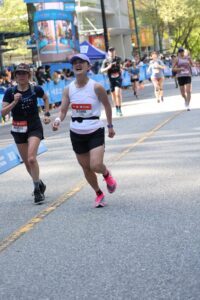
I finished with a time that, if you believe my watch, was around what I’d hoped for. Chip time added a couple of minutes, but regardless, I was extremely pleased.
I’d also been warned that a marathon beats you up worse than an Ironman, and I am here to say that’s the truth. I spent the rest of the day either on the floor, on the couch, or in the bath, and I was in bed by 8:30. My left toes look like someone hit them with a mallet, thanks to all that downhill. My legs are ridiculously sore. I’m only thankful there are no stairs where I live.
But beyond anything, I am pleased with this race. It was hard won, which made finishing it that much sweeter.
October 4, 2024
Ironman Chattanooga Race Report
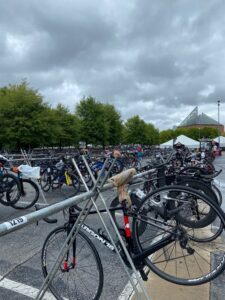
The training for Ironman is never linear, and this time was no different. There were many low points along the way—one shoulder got sore, then the other, then the lower back… and then three weeks before the race, despite being as careful as possible, I caught Covid. Luckily it was a mild case, though I was still coughing a week before the race and was… concerned. But I packed my bags and hoped for the best.
We arrived in Atlanta just in time for Hurricane Helene, and wouldn’t you know it, both Atlanta and Chattanooga were directly in the path of the storm. At that point, all I could do was laugh. Some things are out of our control and we just have to roll with it.
My cough cleared up, and the storm veered—but it rained. A lot.
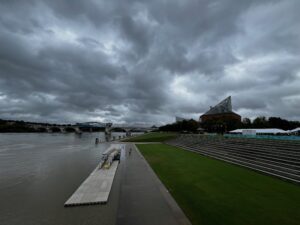
The Tennessee River rose, and with a combination of the high water and high E. coli levels (yuck), the race directors decided to cancel the swim portion. It was the right call, though I was disappointed. A downriver swim would have made it my fastest 4k ever. Apparently, last year someone sent a bag of chips down the river at the beginning of the race and even it made the cutoff.
On Saturday, the day before the race, I decided to drive the new bike course to see what I was up against—along with the infamous Barton Avenue hill everyone was talking about on the run. At the time, it seemed like a good idea, though in retrospect I’m not sure it was. It made me very nervous. Everything looks worse in a car. The hills on the bike course seemed long, and Barton looked terrifying.
This was the first time I was arriving at a start line feeling healthy. Nothing hurt. I was afraid I was coming in undercooked. I had high hopes for the run because my training had gone so well, but after seeing the bike course I worried that I might not make the cutoff.
That evening, my kids went out for burgers and beer and I joined them with my cup of water. Barrel of fun, that was me. But I was being mindful of my stomach. No one wants that disaster on race day. I’d had my main meal earlier (chicken breast and white rice). I managed to sleep, surprisingly, and because of the later start time I was gifted with an extra hour.

Race morning began with a lot of waiting around—not great for the nerves. We were leaving on our bikes by twos in time-trial style, in the order of our bib numbers, and since I was 1221, I had to wait a while. At that point it had already started to drizzle. Both my kids and a friend had encouraged me to bring a rain jacket. The forecast had been calling for rain all week, so I also brought clear glasses to give myself options.
As I stood around, I noticed that most people were wearing sunglasses and very few wore jackets. In fact, most had bare arms. I wondered if I’d made a mistake but figured if the rain stopped and I got warm, I could always take the jacket off and stuff it into a pocket. But the jacket and glasses turned out to be good decisions because shortly after I set off on the ride, it started to pour.
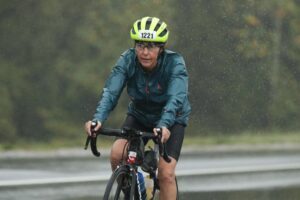
It rained for the entire 180km (well, 174—the course was a little short) and I never took the jacket off. Several times I had to wipe the water off my glasses just to see where I was going, but sunglasses would have made things much too dark.
The new bike course—three loops of a highway—was not exactly inspiring. But it was also not technical—no hairpin turns or super steep descents. Just long undulating hills. I spent a lot of time trying to determine which side of the highway was worse (the return trip), and then I spent time doing math because I’m terrible at it, so that kept me occupied for hours (how fast do I have to be going to come in at a certain time? If this is mile 45, how many kilometers is that?).
I’d done several long training rides so the distance wasn’t a problem. But while I ended up with a fast time for me (7h10), it was not a fast time for the course. There is definitely work to be done in this discipline (stay tuned for a post on lessons learned. There are a lot of them).
And while we’re on that topic, let’s talk about food. My nutrition on the bike consisted mainly (though not exclusively) of a series of peanut butter and jam sandwiches on white bread. Ugh. You’ll see what that produced later, but I’ll warn you now, it wasn’t pretty.
Transition was relatively quick but also quite disgusting because I was soaked and had to peel everything off. I brought choices for the run as well, but this time (thank you, race brain) I made the wrong calls. I looked at my long-sleeve and thought, nope, don’t need that. Looked at my visor and thought, nope, that will bug me. And I left them in the bag.
Within about fifteen minutes, I regretted both decisions. The rain turned torrential (which I’m convinced was karma for all the times I’ve announced how much I love running in the rain). I didn’t care about being wet. What concerned me was that I was getting cold, and this was kilometer five. If the rain continued and I didn’t warm up, there would be trouble.
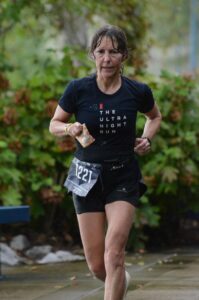
Luckily, it stopped, and eventually I dried off.
The run was a two-loop course, and I was extremely pleased with my first loop—even though Barton was exactly as bad as it looked in the car. In fact, worse, because I hadn’t realized we had to go up both sides of it—twice. I was aiming for a sub-5 marathon, and after the first loop I was right on track. By about kilometer twenty-five, I started to slow down. By kilometer thirty-two, I was taking more walk breaks. By thirty-four, I was broken. My IT band had had enough, my feet were sore, and nothing at the aid stations looked appetizing anymore, not even chicken broth. I had no choice but to walk the majority of the last kilometers.
My kids surprised me on the footbridge back into town, which was the lead-in to the finish line. And then they ran to meet me at the finish—where of course I couldn’t spot them in the crowd. I ended up running a 5h30. Not what I wanted, but still better than anything I’ve done before. Based on the success of that first loop, I know a sub-5 IM marathon is in there somewhere.
The finish was, as always, extremely emotional for me. Ironman training is such a huge commitment. It’s a grueling journey with so many obstacles and sacrifices along the way. When you finally arrive on that red carpet after everything you’ve been through, the experience is unforgettable. I don’t know how anyone holds back the tears. The idea that anything is possible, that you can overcome obstacles and do more than you think—and especially that you can do the thing that scares you—is the reason I do this. The finish line epitomizes everything about that.
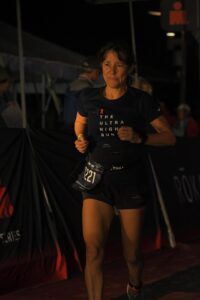
Even though it was late, our plan was to drive back to Atlanta that night because my daughter had to work early in the morning. My amazing children had already fetched all my gear and packed up the place we’d rented. They assured me that all I had to do was sit in the car and all would be well.
I knew very quickly that all was not well. Those peanut butter sandwiches came back to haunt me, and my daughter had to pull over so that I could jump out of the car and throw up. I have never had stomach issues before, during, or after a race, but this time I was very ill. Maybe it was because I’d pushed harder on the run, but I think it was just too damn much white bread.
I managed to make it back to Atlanta without barfing in the car, which was a miracle because I had to beeline it to the bathroom as soon as we arrived. After that, it was straight into the shower and then to bed, where I passed out until nearly 9AM (another miracle—usually I can’t sleep after a race).
I spent most of the next day doing my favorite post-long-workout activity: lying on the floor. Lesson learned from the Florida Ironman: never travel home the day after a race. We celebrated that night with a beautiful steak dinner that I ate very little of and flew home the following day.
Aside from sore quads, a few blisters, and one questionable looking toenail, I emerged from the experience surprisingly unscathed. It took approximately twelve hours after finishing for me to agree to the next one, though the choice is still up for debate: Lanzarote (if that race still exists by then) or Austria. Either way, Ironman #4, I’ll be seeing you in 2026.
August 16, 2024
What If It’s Not Fun Anymore?
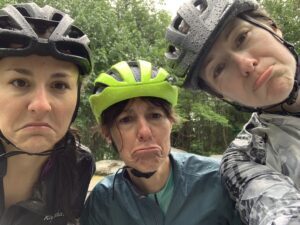
There was an interesting discussion recently on Strava sparked by someone who’s training for an Olympic-distance triathlon. His race date is approaching but his motivation is waning. What if it’s not fun anymore? he asked. How do I keep going?
I think there are two important issues to consider here. The first is burnout. It happens, particularly if you never take rest days or recovery weeks to allow yourself time to recharge and have a bit of a break. No matter which distance you’re training for, rest is an essential part of the process. Even if you don’t think you need it—you do. It’s not just for your muscles.
The second issue involves managing expectations. Who said it was going to be fun all the time? Even if you have your dream job, there will be days when it sucks. There will be aspects of the job that won’t be fun. I spend my mornings writing. I love writing. It’s the thing I was put on this planet to do. There are many days, however, when writing is decidedly not fun. When it takes me four hours to get down a thousand words and I’m not even sure those words are any good. When I realize the novel that I worked on for a year is fundamentally flawed and I need to start again. But those are the days when it’s most important to show up.
In writing, I have always believed the good days are a gift, and you get that gift by putting in the time during the bad days. Training is the same. I love running almost more than I love writing. But sometimes I have crappy runs. Sometimes I don’t feel great, or my legs feel like concrete, or it’s too hot and the run doesn’t go well. Whatever. I still do it. And I still show up the next time.
Mental training is a key part of endurance—in anything, but particularly in Ironman training. Sometimes I think that’s why my coach scheduled strength training for a while as the last workout of the week on a Sunday. Like, wtf? I don’t want to do that. But I did do it, every Sunday. I saw it as equal parts mental and physical training. It was the last thing I wanted to do—therefore, it was especially important to do it.
Nobody said this was always going to be fun. It isn’t. Sometimes you hit a wall with distances. I had to go through so many hard 15km runs before they started to feel easy. But I kept doing them anyway because I know the only way through the hard stuff is… to go through it. My running partner and I set down a solid 28km run yesterday. A lot of it was fun. But all of it? No. By the time you hit 23km, you’re not having fun anymore. You’re challenging yourself to do something that’s hard and uncomfortable, and while it might not be fun, there is value in doing hard things.
This process can be tough. But it makes you tough, too. It makes you resilient and able to put your head down and do whatever you need to do.
My favorite rule from the Velominati is rule #5. Toughen up (well, they express it slightly differently). Get the job done. Yes, there are days when it will be hard, but once you’ve done that hard thing there’s no better feeling in the world.
And take breaks. Have rest days, recovery weeks. You can’t go hard all the time.
August 5, 2024
Mind and Body: Lessons Learned

Nearly every long workout offers lessons, and I’ve had some good ones over the past few days.
I’m consistently surprised by how much our minds can f*ck with us. Mine is an expert at causing trouble. It routinely tries to convince me that I can’t do something and therefore shouldn’t attempt it. It can even create phantom physical symptoms. I have been known to suddenly develop a “sore” shoulder before a swim that I didn’t feel like doing.
But what I want to talk about here is Friday’s run. It was long, and I was feeling nervous. Last week’s stupidity with those Instagram exercises was a reminder that the wheels can come off this little project at any moment.
But that usually only happens when you do something you’re not prepared for—which is why I have a coach. My build has been gradual and very conservative. Anything that’s in my schedule is something I’m trained to do.
So, when I texted her the night before the run with sudden knee niggles, she intuited it as head games and said, “Go anyway. I think you’ll be fine.”
And I was. It was just my head saying, you’re not ready, you can’t, you shouldn’t. But I was ready, I could, and I did.
This is not to say we should ignore the voice in our head all the time. But we need to develop a sense for when it’s telling us something useful and when it’s messing with us and should be ignored. That’s not always easy. I had some serious hesitations as I laced up my shoes that morning. Is this the day everything goes to shit?
Thankfully, it wasn’t.
Ironman is all about questioning our self-imposed limits, which is one of the many reasons I love it. It takes those limits and crushes them. It challenges us to do things that seem impossible but are absolutely doable when we take them one step at a time.
We can do more than we think. I have to remind myself of that nearly every day.
Now, onto body lessons which came in the form of another workout: the long ride.
A few years ago, I invested in a bike computer which opened up a whole world of riding—since I am an expert at getting lost and normally wouldn’t go places that I don’t know. So, I’ve been shaking up my long rides by trying new routes in unfamiliar places. This has both advantages and disadvantages. The advantages: it’s more fun. The rides become adventures. Instead of thinking about the distance, I’m seeing new things and not incidentally making sure I’m going the right way.
I love my bike tech but I do not fully trust it. Batteries run out. GPS gets confused. I always write out the turn-by-turn directions on a couple of index cards and bring them with me. It takes a bit of time, but I have never, not once, regretted doing it. Occasionally, Garmin likes to throw in random make a U-turn messages. Sometimes it’s clear that I’ve taken a wrong turn. But at least twice yesterday, the U-turn messages were totally wrong, and my index cards saved me from riding around in circles like a clown trying to figure out which way to go.
There is one big disadvantage, however, to riding in an unfamiliar area: you don’t know where to find water and bathrooms. Of course, I checked on the map before leaving and marked places along the way where I was fairly certain there would be both water and a bathroom. I made sure there weren’t too many miles between these places so I wouldn’t get stuck without either. And that was it, I was good to go.
Turns out, fairly certain isn’t certain enough.
First of all, I wildly overestimated the capacity of my bladder. Thank goodness it was early in the morning when that happened—no traffic, lots of bushes, no shame.
But more significantly, I was very wrong about the availability of water. This was a seven-hour ride, and while the first few hours were relatively cool, the temperature soon soared to 33 degrees. I filled up my bottles once but had marked a spot for the next fill that was WAY too far away given the demands of the weather. I found myself out of water in the middle of nowhere. All there was around me was farmland. No parks, no gas stations or coffee shops—nothing.
Pretty soon my legs started slowing down and I began wondering what I was going to do. I finally reached a park—the place I’d marked as a fairly certain bathroom/water source—only to find… an outhouse. In other words: no water.
I stopped to ask a group of people if they knew where to find water. They didn’t. But one of them must have sensed my distress because he offered me a cold can of Seven Up. It was the only thing that saw me through to Fort Langley where I could fill up my water bottles. Without it, I probably would have had to knock on a stranger’s door.
Because of the lack of water, I also couldn’t douse my head. Seven hours in the sun is a lot, and there was almost no shade on the route I’d chosen.
However, lessons learned from previous rides: I had left my car at a shady park and brought both food and water for post-ride. These things were lifesavers. After the ride, I lay on the grass for a while, ate a muffin and drank some water, and then hoovered down two A&W chicken burgers on the drive home.
I’m fairly certain that’s the last time I’ll make that mistake. But there will be new ones, of that I’m sure.
July 29, 2024
Notes from the Build Phase
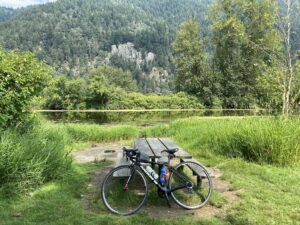
The big push is on. The distances are climbing. The fatigue is mounting. Consuming enough food has become a serious challenge, as has staying awake in the middle of the day. I’m getting sick of pasta. I was already sick of rice. Chicken breast? Starting to annoy me. But I’ll never be sick of bananas.
The race is not until the end of September (exactly two months from today, but who’s counting?), though I don’t feel ready. I don’t have to feel ready yet—but I know even now that I won’t feel ready come race day. And as a swimming friend once said (and it’s my favorite Ironman quote), “You’re never ready for Ironman.”
The bike is going to be tight. I’m not a fast rider and it’s a relatively tough course. If I have a mechanical failure, there’ll be trouble. I’ve started practicing tire-changing again, which is a good thing because my skills are rusty. By the end of September, I need to have it down to a science.
I’ve also started amping up my effort on the shorter rides and doing more of them. Five out of six days of workouts now include riding. But it’s good. I’m already seeing improvements in my strength. And I know having several big ones under my belt will give me more confidence. I did a long one last weekend in the valley and it was tough but good. I’m hopeful it will come together eventually. It did for Florida. All those long days in the saddle paid off—but they felt terrible at first. I remember ending those first few 160km rides with my daughter and thinking I can’t do this. What have I signed up for? Until the one that we finished and looked at each other and said, “We can do this. We’ve got it.”
And then there’s Race Brain. My physio confirms this is a thing, so I feel a little better about my occasional moments of baffling stupidity during which I decide to do something like, oh, I don’t know, try the exercises from some random dude on Instagram because they look like they might be just the thing my body needs. Guess what? Not only are they not just the thing, but when I showed them to both my physio and my chiropractor (since I needed to see both after doing the exercises), they shuddered in horror.
But when you have Race Brain and you’re at this stage of training, you’re always looking for the thing that might help battle the aches and pains or give you an edge somehow. No. From here to the start line, I have vowed to stick to what’s been working and ignore anything that pops up on my Instagram feed.
As for swimming… My left shoulder got better, so my right one decided to act up. Hello, Ironman training. Swimming was going great, and now I’m barely doing it. Three things give me hope. One, it’s a downriver swim. Two, I have a strong swimming base so it should be easy to build it back up again once I’m better. And three, my physio and chiropractor (have I mentioned them yet?) are fabulous, and I know they’ll both help me get there.
I don’t want to jinx my run training, so I just won’t talk about it. I’ve got a great new pair of shoes. That’s all I’m going to say.
“You’ll be fine,” my daughter reassured me this afternoon. “You’ve never not been fine.”
True. But in the meantime, fear is an excellent motivator.
July 2, 2024
Canada Day Challenge 2024
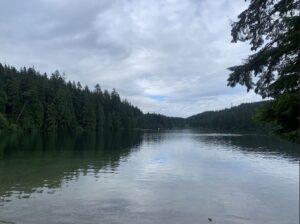
This race has become an annual tradition for me. VOWSA (the Vancouver Open Water Swim Association) always does a great job. The event runs smoothly, starts on time, and … there’s food and coffee! Plus, it’s at Sasamat Lake, one of my favorite places to swim.
This year, however, I approached it with a bit of trepidation. I’d signed up for the 4K event as a training swim for Ironman, which seemed like a good idea at the time (as these things tend to do). Then, about six weeks ago, a calcium deposit appeared suddenly in my shoulder, and I went from great to zero in terms of swim training. Luckily, the issue resolved itself with one session of shock wave therapy, but I had to take it easy for a few weeks afterwards and could not put in the training I’d hoped for this race.
And then I decided to move. On June 30th. The day before the event. (Not recommended). So, I woke up on Canada Day feeling a little beat up and not especially excited about getting into the water to swim a distance I wasn’t ready for. The longest open water swim I’d done before this one was 3200m. But I’d put in several 3K training swims in the pool and my coach felt that if I approached the Canada Day swim as a training day and kept it relaxed, it would be fine.
She was right (she’s always right).
It’s nice when you can build off previous experience for these things. I knew from swims I’d done in the past that it’s important (for me, anyway) to start slowly. So many people burst out of the start only to run out of gas in the second lap. It’s not easy to restrain yourself when everyone around you is making a mad dash, but it always pays off in the long run.
I’ve also learned that the worst thing you can do is think about how far you have to go. I mean, that’s a rule that applies to all long-distance sports. Do Not Think About It. There’s no point. You’re doing it regardless, so why make it harder than it already is? Be in the moment. And for me, the moment in swimming means focussing on technique. Good technique will automatically make you faster. In open water, being in the moment also means sighting efficiently (because why swim farther than you have to—and in the wrong direction?). And in open water racing, it means finding someone to draft off.
I managed to kill a lot of time doing the latter—and in the process, making the swim easier for myself. Drafting is easy. Finding the right person to draft off is hard. Optimally, they need to be just a tiny bit faster than you are so that they force you to work a little harder—but because you’re in their draft, you’re actually not working that hard. Drafting in a swim race is key—and it’s legal (unlike on the bike in a triathlon, where drafting gets you a penalty). If you’re not doing it in the water, you’re putting in too much effort for not enough reward.
I never really found the perfect person in this race. They were either a little too slow or a little too fast. But in the meantime, I entertained myself and had an easier swim. Hopefully I provided the same service to whoever was hanging out behind me.
I also can’t say enough about having a good wetsuit. Not just one that fits properly—although yes, that, because if it doesn’t, it can impact shoulder mobility and even restrict your breathing. But also one that is made well. I lucked into a very nice wetsuit thanks to a friend who bought it online in a sale and then couldn’t return it when she discovered it didn’t fit. It’s extra buoyant in the hips and legs but super thin in the arms and shoulders—which is exactly what you need in open water.
I made sure to grab some new goggles before this race after mine had leaked in Squamish. Finding a tried and true brand for yourself is also important. I had to endure a series of leaky ones before I found the goggles that work for my face. Even so, I end up with raccoon eyes for the rest of the day, but at least I’m comfortable while I’m swimming.
Two lessons I took away from the day:
· Neck chafe. Ouch. I need to figure this out. It’s the second time now that it has happened and it’s preventable.
· Adequate post-race fuelling. I didn’t eat enough afterwards and had to grab an emergency chocolate bar when I was out later in the afternoon. I know, that sounds made up, but it was real—and I should know better. At this stage of training, I’m always an inch away from bonking, and that’s dumb. This is also preventable, and I need to get on top of it.
All in all, it was a terrific day, a successful race, and a good confidence-booster for what lies ahead.
June 17, 2024
The Oddball 70.3
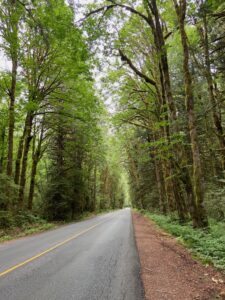
Yesterday I did what my coach called an Oddball 70.3 training day up in Squamish. The plan: a 3k swim, 90k ride, and 18k run.
In terms of lessons learned, this was an excellent exercise. It definitely showed me what was going well and what needs work.
We drove up to Squamish in the pouring rain, which was a little ominous—but I figured you can’t choose your weather on race day, so I had packed accordingly and made my peace with the conditions. Luckily, as soon as we arrived, the rain stopped. Still, the air was very cold, as was the water, and I was glad I’d brought ALL my neoprene. I wore everything: wetsuit, booties, gloves, vest, and neoprene cap. And I had no trouble staying in the water for as long as I did.
I ended up swimming 3200m and was pleased with how I felt. It was much better than I’d expected. I’ve done lots of long pool swims this year but not much in open water. I was especially pleased with the way the swim rolled off me afterwards as if I’d done nothing. That is always my goal with this portion of the race. In fact, later in the day when I was doing one of many run loops around Alice Lake, I looked over at the water and thought, oh yeah, I swam there this morning. I’d long since forgotten.
It was also great to have my son in the kayak. I was the only fool out there in that weather, so I would have felt nervous being alone.
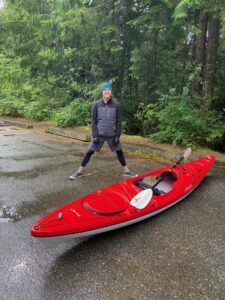
It took us a while to sort ourselves out after the swim, having to deal with the boat, but once we got on our bikes the ride was lovely. The roads were beautiful and quiet. My son rode with me for the first 40km, but it was only after he left that I started to learn a few things.
I used to ride alone a fair bit, and it was excellent mental training for withstanding the head games of a long Ironman ride. Now I do most of my riding with a group. Three things happen in those rides. I ride slower, I have people to talk to, and we take a LONG coffee break in the middle. Yesterday I found myself struggling with the mental game and not being able to push as hard as I wanted to. This was a flat route, but there was a lot of headwind, and I ended up slower than I would have liked. Though also worth considering—while I might have forgotten the swim, maybe my body hadn’t. Rule #5 was definitely one of my mantras on this ride.
I was having some chain issues, and then just shy of 89km my derailleur hanger snapped and that was the end of my ride. At least it happened near the end, and this wasn’t an actual race. That said, I would have been close enough to the finish to carry my bike over the line, but I’m grateful I could call my son to come pick me up. I didn’t feel like hiking up a big hill in my cycling shoes.
Onto the run. I did one loop of the Four Lakes Trail and that was enough of the trails for me. I’m a huge fan of Pacific Spirit Park trails with their moderate hills, but the extreme ups and downs of traditional trail running are not my jam at all. I found that to be very hard—and hard on my body. So, as soon as I could, I got out of there. My choice—to run down toward Paradise Valley Road—was, in retrospect, not much of an improvement, because I had to come back up again. I did more elevation on the run than I did on the bike.
That said, I was pleased with my run. It was a strong effort and I felt good. Had the terrain been more like what I’m used to, it would have been fast (for me).
A few things to keep in mind for next time: I forgot to use Body Glide before I got in the water, and I paid for that with some nasty neck chafe from my wetsuit. I also forgot to wear my ear plugs and came out of the water dizzy.
Note to self: salted pasta has limited appeal. After a while on the bike, I couldn’t look at it anymore.
Final note to self: I need some mental strategies for dealing with the long quiet ride I have ahead of me. Staring at my bike computer and wondering why the average speed isn’t going up is not a productive way to spend the time. Suggestions are welcome. During Florida I tried to do math (converting miles to km’s) and because I’m bad at math it kept me occupied for quite a while. So, that will work, but it’s like salted pasta—it only goes so far.
I’m not gonna lie. I found myself questioning a few of my life choices yesterday and regretting having signed up for Chattanooga. However, it’s done. I’m going, one way or another. All I can say is thank God it’s still June. I might have to watch more of David Goggins‘ YouTube videos.
We ended the day at A&W with a much-deserved burger. Then I had a long bath, went straight to bed and slept for over eight hours. Now, to get my bike repaired and figure out the next steps on this very questionable road.
April 7, 2024
What Did I Forget?
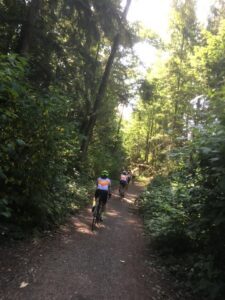 First club ride of the season was on Saturday. What did I forget?
First club ride of the season was on Saturday. What did I forget?
A lot, as it turns out.
I forgot how fun it was to be outside. How lucky I am to belong to such a wonderful cycling club. How great to do long rides again—though this one actually wasn’t very long but it felt like it, because…
I also forgot how hard it is to ride outside and how much it takes out of me. Man was I tired when I got home. Training indoors is great but it is definitely not the same. Headwinds and traffic are the obvious differences, but just getting your outdoor legs back takes some getting used to. I hadn’t been outside for a long ride since August (thank you, concussion).
I didn’t bring enough food. I forgot how hungry I get out there. I also didn’t drink enough. I forgot that my winter gloves keep my hands warm but don’t allow any manual dexterity (i.e. for opening food bags while riding).
I forgot how much safer I feel riding in a group of people who are all alert and watching for every possible obstacle. So much nicer than riding alone.
I forgot that hills always look harder before you’re on them. Except for that damn hill on my way home. That one never gets easier.
I remember now that this is a process, and that every season starts out the same. The first few shorter rides make the longer ones seem like they’ll be impossible, but you work up to it slowly. It’s hard, until it’s not. And then you find more hills, and it gets hard again.
Looking forward to a great season of riding!
April 5, 2024
Six Months to Race Day…
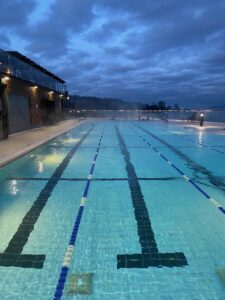 Sounds like a lot, doesn’t it? But it passes quickly. From where I’m standing now, it’s hard to imagine being ready. I am comfortably swimming around 3k, riding about 60k and running 12-14k. And not all in one day. Which means I have a loooong way to go.
Sounds like a lot, doesn’t it? But it passes quickly. From where I’m standing now, it’s hard to imagine being ready. I am comfortably swimming around 3k, riding about 60k and running 12-14k. And not all in one day. Which means I have a loooong way to go.
But it always seems impossible to imagine doing one of these races. You never actually think you can do it—until you’re doing it. The key to the training is: slow but steady. Don’t panic. Keep the increases gradual and take rest when it’s scheduled.
I’ve had some developments on the maturity front (haha, who would have thought?). A few weeks ago, I felt a twinge of something during a strength workout and stopped right away. The next day was a run day which, if you know me at all, you’ll know I DO NOT want to miss. But I decided not to run so that I wouldn’t make things worse. I ended up missing two run days and was back on my feet shortly afterwards—no harm done.
This is extremely uncharacteristic for me. Normally I would push through, run anyway, and then suffer through weeks of injury. I have finally learned that nipping things in the bud is far more effective and causes much less suffering overall.
One of the things that’s important right now is mental training. I find swim workouts and strength are particularly good for that. I can negotiate my way into a pair of fins in seconds, which of course makes the workout easier but doesn’t benefit me. I have not allowed myself to succumb to those moments. Same with strength. It’s so tempting sometimes to just… skip those last few exercises and call it a day. But I force myself to finish the workout regardless of how I feel about it.
These things may seem small but they accrue over time. The more willing you are to cut corners, the easier it becomes to talk yourself out of doing hard things. And now, as I move into these next six months, things are only going to get harder. Building that inner mental strength is key to being able to last through the long workouts—in fact, to not mind doing them. To (dare I say it) like them. Yes, that happens.
My main challenge now is to stay healthy—COVID-wise, injury-wise, fatigue-wise. I’ll start posting more often about the training as it progresses. Up to now, there hasn’t been much to report. I’m doing speed work in the pool and have just started actual workouts on the bike. Club rides start next weekend, which is great. Masters is almost over, which is sad. It passed too quickly. I’ve also started brick runs—little ones, so they’re easy. Hopefully that will mean that when they get longer, they’ll still feel easy.
But maybe that’s too much to hope for.
January 24, 2024
2024 … In Theory
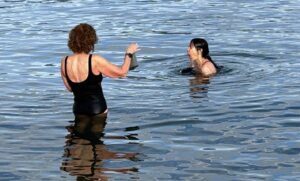
Happy (very belated) New Year, everyone. January is the time to plan races and figure out what the coming year will look like—in theory, anyway. But theories are good, so here’s mine.
Having made a full recovery from last year’s stupid concussion, I have thrown myself into training for Ironman Chattanooga which will happen at the end of September. So far, I have not been able to persuade (coerce) my daughter (partner in crime) to join me, but these are early days. And I’m committed to doing it even if I have to go it alone.
I’m still working with my wonderful coach, so, unlike training for Florida when the clowns were in charge (the clowns being me), this time I’m listening to someone who knows what they’re doing. Much safer. My job is to stay upright and not skip my strength workouts, eat and drink the right things, take rest when it’s scheduled (and not do more just because I’m feeling good), and get good sleep. I will also see my chiro regularly, take weekly cold-water dips in the ocean, and stretch and roll on a regular basis
Simple, right? In theory.
I’m trying to give myself the best chance of making it to the start line, which means I’m wearing a mask in congested places, I probably won’t go skate-skiing this year, won’t ride my bike outside until the weather improves, and won’t race a 70.3 as preparation. The latter is a common thing for people to do who have a full Ironman on their schedule, but I know myself well enough to know it’s risky. I’ll do a 70.3 as training on my own, without the little voice in my head pushing me to go faster—consequences be damned—because it’s a race.
The plan is not foolproof, because shit happens—as I well know from last year when I was perfectly prepared for everything I had signed up for and then decided to hop a curb and misjudged my footing. Won’t be hopping any curbs this year either.
The coming year will include the Canada Day 4k swim at Sasamat, the Victoria 140-km fondo, some long rides out in the valley, long runs in Pacific Spirit Park, masters swimming, and whatever the Lomas have in store for cycling season.
I can’t wait!
If you have plans for the new year, please share them. I’d love to hear about them.
Happy training!
Hearing Voices
This is a blog for writers and readers who love to hear voices. ...more
- Michelle Barker's profile
- 61 followers



